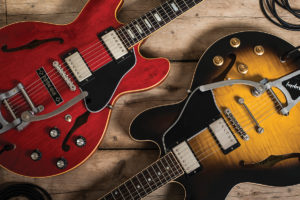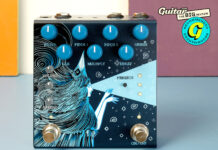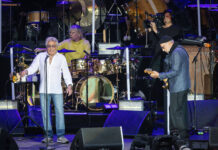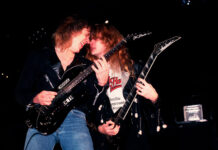
Revive Your 335: Get pro tone from your Gibson or Epiphone
Gibson’s thinline Electric Spanish guitars have been used to give the world some of the greatest rock, pop and blues guitar tones in the history of hot wax.
From Chuck Berry, BB and Freddie King to Clapton and Carlton to Bernard Butler, Noel Gallagher and Dave Grohl, the list of artists who’ve rocked a Gibson semi is as glittering as it is varied.
Much like the other three members of the ‘big four’ that have carved out a place on the electric guitar’s Mount Rushmore – the Telecaster, Stratocaster and Les Paul – it’s hard to imagine popular music as we know it without the soulful stamp of semi-acoustic Gibsons deeply embedded in its grooves.
If you’re an ES-335 owner already, we’re preaching to the choir. If you aren’t? There’s a reason that some tonehounds refer to these guitars as ‘burst killers’. That creaking sound you can hear? That’s your wallet, grimacing at the inevitability that flicking through the following pages will cause gear-lust to strike.
The good news is that you don’t have to spend a fortune to sound great. Whether you want to get more from a Gibson or you think hot-rodding your Epiphone will take it to the next level – or even if your thinline semi sports another brand name on its headstock – read on for tone tips, easy mods, upgrades and buying advice to help you along the way. Join us then, as we go through the f-hole…
The Gibson ES-345 was introduced in 1959, a year after the 335. This first-year example still has its original case and PAF humbuckers
Family HistoryOf all the classic electric guitar designs, only the Stratocaster rivals the ES-335 for versatility – and it was a hit from the off…
It’s hard to think of a guitar-based musical genre in which the ES-335 hasn’t featured in some way. The variety of sounds on offer resulted from a fusion of design ideas, as Gibson responded to the needs of its mid-1950s customer base.
Applying the company’s archtop heritage to the new demand for electric guitars that were more controllable at higher volumes, Gibson’s then-president Ted McCarty “came up with the idea of putting a solid block of maple in an acoustic model. It would get some of the same tone as a regular solidbody, plus the instrument’s hollow wings would vibrate and we’d get a combination of an electric solidbody and a hollowbody.”
This principle wasn’t a million miles away from Les Paul’s Log prototype that Gibson rejected shortly before the United States of America entered World War II. Yet rather than starting with a solid centre-block and adding hollow wings to make the instrument look and feel more like a guitar, McCarty inserted the centre-block into a double-cutaway, 16-inch thinline archtop – it was a natural evolution from the thinline-bodied ES-225, ES-350T and Byrdland that had arrived in 1955 following player requests for guitars that were easier to handle.
In addition to its feedback-reducing properties, the hybrid ES-335 design would deliver an even balance, light overall weight and a comfortable seated playing experience – addressing the concerns of many late-50s Gibson customers, for whom the small and heavy Les Paul Model was still something of a white elephant.
Yet when it entered production in April 1958, the revolutionary ES-335 benefited from the various technological advances that had recently been applied to the Les Paul, in the shape of new PAF humbucking pickups, a tune-o-matic bridge and stop tailpiece. Most sources agree that 317 of Gibson’s new thinline semis left the factory that year – 267 in sunburst (ES-335TD) and 50 in natural (ES-335TDN), marketed at $267.50 and $282.50 respectively. The upscale ES-345 and ES-355 models were officially introduced in 1959, although 10 ES-355s shipped in late 1958.
Nearly six decades later, 1958 might appear to be the year that King Midas came to work for Gibson’s R&D department. In reality, the other big launches that year – the sunburst Les Paul, the Flying V and the Explorer – all crashed and burned by 1961 and had to wait to be rediscovered by new generations of players. Not so the ES-335, which was an immediate hit and has remained in continuous production ever since.
Numerous variants would be spawned in the decades to come, but early close-cousins the Epiphone Sheraton (1958) and Riviera (1961) have obtained classic status in their own right. Modern entry-level versions have been responsible for many a guitarist’s first encounter with an ES-335 type guitar – the Epiphone Dot (street price £349) is still one of the best bang-for-buck electric guitars on the market and it offers huge upgrade potential – turn the page to find out how…
Nuts & Bolts
Before you even plug your guitar in – and this goes for any electric, not just thinline semis – you can have a huge influence on your amplified tone simply by ensuring that your guitar is set up to your liking, in tune and intonated properly. It’s a good, old-fashioned domino effect: a guitar that is comfortable to play will help you relax and play better, and you’ll sound better into the bargain as your playing becomes more confident, fluid and articulate.
Experiment with different string gauges and action heights and find the combination that you like the best. Our preference is a set of 0.011s on a Gibson as the nominal 24.75-inch scale length allows for easy bends while still offering a little fight. A heavier set will also help with stability if you have a vibrato installed.
For a slinkier feel with a stopbar tailpiece, try ‘top-wrapping’. Instead of threading the strings through the back of your tailpiece in the traditional manner, thread them in from the front and wrap them back over the top. Billy Gibbons is a fan, and Joe Bonamassa swears that it makes a set of 0.011s feel like a set of 0.0105s. Top-wrapping also allows you to screw the tailpiece right down for maximum resonance without creating a break angle over the saddles that’s too steep and risking string failure as a result.
On the subject of stop tailpieces, some vintage tonehounds profess to prefer the sonic properties of lightweight aluminium. Locking units from TonePros are another popular retrofit. 1965 saw the arrival of the trapeze tailpiece on the ES-335, and while they have their detractors, there are those who like the slightly more relaxed feel that comes from the shallower break angle and there are plenty of spooky textures accessible by playing behind the bridge.
We’re not going to make many friends at retrofit tuner companies here but honestly, the majority of tuning difficulties have very little to do with your machineheads and are likely down to friction at the nut or bridge – you’ll often hear a tell-tale ‘ping’ when tuning if a string is binding in the nut. This can be eased with a lubricant such as Big Bends Nut Sauce or cheap and cheerful pencil graphite.
The choice of nut material itself is also worthy of consideration. Unbleached bone is the preferred choice for many luthiers. Aside from benefits to tone, sustain and tuning stability, it’s also mildly self-lubricating and porous, so it absorbs any additional lube you apply and stays slippery, reducing friction. Most bone used in the guitar industry is a by-product of animal farming – vegetarian and vegan-friendly alternatives include Micarta (a compound of phenolic resins) and Tusq (a man-made alternative to ivory).
Saddle Sore
The tune-o-matic bridge was another slice of Ted McCarty genius; it debuted on the Super 400 in 1953 before finding its way onto the Les Paul Custom the following year. In its first ABR-1 incarnation, the saddles were nickel-plated brass. In an effort to minimise rattle and vibrations, Gibson was using nylon saddles on several models by the mid-1960s. These days you can easily swap your saddles for a different material – it’s an affordable mod that can have a dramatic effect.
Graphite and the aforementioned Tusq have their fans – the former is claimed to reduce string breakages and the latter offers bone-like sustain and harmonics. Reducing friction is always a good idea when using a Bigsby, and nylon saddles work particularly well for that. They also have a somewhat softer attack and sweeter high-end than brass or steel and deliver a tone that sounds a little more ‘vintage’ to our ears.
Some players – Joe Bonamassa included – have been known to try a half rice/half chips approach with metal saddles for the wound strings and nylon for the plain strings. Experiment and see what works for you!What the hell is a Varitone anyway?
Gibson’s original ES-345 and ES-355 models came equipped with a six-position rotary switch called a Varitone. If you’ve ever searched online for an explanation of what a Varitone does and how it works then we’d wager the phrase ‘tone suck’ wouldn’t have been be too far away – the Varitone seem to be one of those subjects that people get irrationally worked up about on internet guitar forums, much like relic’ing and the Second Amendment.
Kings Freddie and BB seemed to put their Varitones to pretty good use, but on the other hand, there’s a 14-year-old in Idaho who says that you should rip that tone-sucking POS out of your guitar immediately. Who to believe?
In simple terms, unlike the regular passive tone controls elsewhere on your guitar, the Varitone doesn’t act as a low-pass filter, it’s effectively a notch filter that takes preset slices out of the midrange, resulting in a selection of tones that are increasingly more nasal than their full-fat bypass equivalents. An 1.5H choke is housed beneath the treble pickup and it fixes the range of the notch.
The first position on the switch is the bypass, while positions 2-6 traditionally cycle through 1,000pF, 3,000pF, 0.01µF, 0.03µF, and 0.22µF capacitors. Each cap is paired with a 10M resistor to avoid pops when switching.
The bypass setting itself is the cause of much consternation as many ES-345 and 355 owners have argued that their guitars sound better with the Varitone circuit removed altogether, but from an electronic standpoint the difference in frequency response is negligible – in an A/B test the contrast between the sound of your regular tone pot set wide open and the sound of the tone potentiometer removed from the circuit altogether would be considerably more pronounced.
Of course, not all Varitones were created equal. Over the years, changes to the recipe have resulted in bypass modes being less than transparent on a variety of Gibson and Epiphone models. Issues caused by summing out of phase pickups to mono with a stereo
ES-345 or 355 model can also muddy the waters but there’s no doubt that the original Varitone circuit does offer some cool and interesting tones for funky chords and expressive lead lines that go way beyond the regular ES-335 palette – as ever, let your ears decide!
Hardware Store
We’re Bigsby fans here at The Guitar Magazine, and we make no apologies for it. As long as it’s been correctly lined up during the installation process and your bridge and nut slots are well-lubricated (stop smirking at the back), a set of strings that have been properly stretched in should offer relatively trouble-free tuning – even with fairly vigorous use of the whammy bar.
When it comes to fitting a Bigsby it’s a straightforward enough mod, but the model that you choose will likely depend upon how squeamish you are about drilling holes in your guitar’s top. Whichever you choose, we’d always recommend going for the USA-made, sandcast aluminium version.
The Towner Down Tension Bar allows you to get a stopbar-style break angle over the bridge
A Bigsby B7 (above left) looks the part on an ES-335 from a vintage perspective and features an integrated tension bar – this creates enough of a break angle over the bridge to stop strings leaping out of their saddles when attacked with venom – but the unit is screwed directly into the top as well as through the end-pin hinge plate. Four small end-pin screw holes aren’t too obtrusive but the same can’t be said for the two-hole ‘snakebite’ left behind by a B7 on the guitar’s top, should you decide to remove it.
If you’ve fitted a B7 to a guitar that previously had a stop-tailpiece rather than a trapeze, you might find you want to cover up the now-redundant stopbar stud holes. Aside from employing the services of a luthier to fill the holes permanently, options include a reproduction of the ‘Custom Made’ plaques used by Gibson (visit philadelphialuthiertools.com and they’ll engrave one with whatever wording you like for $22.99) or if you fancy going down the DIY route, we’ve seen round-head bolts, pearl and nylon studs and various other items used to cap off the holes.
Another thing to consider is that an ES-335’s ground wire is usually connected to one of the stoptail stud bushings – with the stopbar tailpiece removed the ground wire will need to be relocated. Gibson’s factory solution for ES-335s with Bigsbys was to route the ground wire through a small hole near the rear strap button, then screw the Bigsby’s hinge plate down on top of the exposed wire. Alternatively you can drill through the rear wall of the bridge pickup cavity into the treble-side post hole for the tune-o-matic bridge and send the ground wire through the drilled hole, anchored by the bridge post at one end and soldered to the bridge pickup’s braided wire shielding at the other.
If all of that sounds like a pain in the tailpiece, you have other options. A Bigsby B3 or B6 doesn’t have a tension bar, so you don’t need to drill into the arched top of your beloved instrument. However, neither option creates much downward pressure on the bridge due to there being a very shallow break angle across the saddles. What’s more, the stopbar is still redundant, so you’ll need to think about grounding.
So far, this doesn’t sound easier but with the addition of a Towner Down Tension Bar (townerusa.com) you can create a stopbar like break angle over the bridge but still get smooth Bigsby performance thanks to the Towner’s roller bar. And you won’t need to relocate the ground wire either, as the Towner hooks onto your existing tailpiece studs, which you can adjust to taste. It’s an ingenious ‘best of both worlds’ solution.
If you can find one, we’d recommend tracking down a Bigsby B6CB – it’s a Gretsch part, but it has a huge advantage over the regular B6. Rather than there being a channel for the strap button to sit in, there’s a central hole in the hinge plate through which the screw passes and the strap button sits on top. This not only makes it less fiddly to secure your strap but – assuming your strap button is positioned dead centre – it makes installing the B6CB with the correct alignment a breeze.
If you want to install a Bigsby B7 on your ES-335 without leaving any trace or having to relocate the ground wire then Vibramate’s V7-335 kit (vibramate.com) doesn’t require any drilling thanks to its system of mounting plates. The Vibramate hardware does add a little weight and there’s a subtle colouration of the tone compared to a B7 that’s been screwed directly into the body, but it’s a great way to audition a Bigsby without creating sawdust. For an alternative ES-335 vibrato option that doesn’t require drilling and has a different feel to a Bigsby, then check out the Stetsbar (www.stetsbar.com).
Be quiet and drive
One of the major unintentional upsides of the fact that more and more venues are insisting on whisper-quiet stage levels these days is that it makes low-wattage amplifiers and feedback-prone guitars with unpotted pickups more viable for gigging than they’ve been in decades. When stacks were king, it was almost impossible for all but the most pampered stadium rockers to make fully hollowbody guitars behave, and even centre-block equipped guitars such as the ES-335 could be problematic in some instances.
F-holes stuffed with rags or foam are probably less necessary these days, but something that’s relatively unexplored is how the resonance frequency of individual speaker types can impact on the onset of feedback. While auditioning speakers for a bespoke amp build recently, we noticed that two ostensibly similar alnico-magnet, 12-inch drivers – the Celestion Blue and the Warehouse Black & Blue – interacted with the guitar very differently.
Feedback happened a lot sooner with the Warehouse speaker to the extent that our ES-335 started to behave more like a fully hollow ES-330 and was hard to control. The reason is almost certainly that the resonance frequency of the Warehouse (106.73 Hz) is in the low-midrange danger zone that tends to promote feedback with a semi, while the Celestion’s lower 75Hz rating is safely out of harm’s way.
As ever, it’s about the way your guitar, amplifier and speaker interact: you might find that a speaker with a higher resonance frequency adds punch to a Telecaster. If feedback is a problem when using your semi at volume, trying swapping your speaker for a driver with a lower resonance frequency rating before giving up on your guitar or amp.
Pickup Lines
What if your ES-335 is playing like a dream but just doesn’t cut it when you plug in? A pickup change could be in order. Retrofit pickups aren’t a silver bullet for all of your tonal ills – you might find that a very good set of pickups throws the shortcomings of your guitar into sharper focus in the same way that a high-quality microphone is unlikely to disguise the imperfections in a dubious vocal performance.
That said, there are plenty of humbuckers that suffer from being rather one-dimensional compared to vintage and vintage-style units. If you feel like your pickups are constricting or strangling your guitar’s natural voice then there’s never been more choice when it comes to replacements.
Early ES-335s came loaded with PAF humbuckers and the extended high-end, touch-sensitivity and harmonic content offered by a really good set of PAF-style units can be a revelation. Assuming you don’t want to drop second-hand car money on a set of vintage Gibson ’buckers, you won’t go wrong with Monty’s PAFs (montysguitars.com), Tyson Tone Preachers (tysontone.com), Mojo Pickups ‘Vintage’ PAFs (mojopickups.co.uk), Lollar Low Wind Imperials (lollarguitars.com) or Bare Knuckle’s VHII units (bareknucklepickups.co.uk).
Once your Gibson or Epiphone semi is loaded with a killer set of pickups, there’s an extraordinary range of tones on offer. Head to youtube.com/theguitarmagazine to see a video of blues-rock guitarist du jour JD Simo demonstrating a remarkable array of sounds using his beloved 1962 cherry ES-335.
Alright Jack
Most Gibson semis have their output jack sockets situated on the top of the guitar, behind the volume and tone controls near the tail. On such a large-bodied instrument it’s unlikely to interfere with most people’s playing arc, but we’d still recommend using a cable with an L-shaped plug. When the red mist descends there’s less risk of a windmilling arm making contact with the plug and damaging the jack socket or worse still, cracking the top. You can also guide the lead between the body and strap in a tidier fashion.Know Your Tone
While we’re confident that almost everyone reading this will be familiar with rolling back the tone with gain to nail Clapton’s ‘woman tone’, but there’s another cool trick that works particularly well with an ES-335. In order to add depth to the bridge pickup tone while retaining bite, first flip your pickup selector switch to the middle position.
Then roll the neck pickup volume back a couple of notches, stopping at the point at which you hear the bottom end of the neck pickup shelve off. The result? You’ll get a thicker version of your bridge pickup tone without any flab – it’s a fantastic rhythm sound that works particularly well for filling space in a live mix if you are the only electric guitarist in a band.
Vintage Trouble’s Nalle Colt is primarily a Les Paul guy but his advice is transferable for players who use vintage-style ES-335s:
“I ride the volume control a lot, that’s my whole thing. Since we started this band I’ve liked to get kind of a gritty amp and then just turn down to get it to clean up. There’s something so nice when you hear that volume go up and it just feels and sounds natural.
“[For rhythm] I’m usually set about five and a half or six on a Les Paul, in the middle position. Then you can just turn down the bass pickup a little bit – it’s amazing. The stuff you can do is incredible, there’s a thousand sounds in it if you work at it. You’ve got to fight the adrenaline as usually you get on stage and end up just flipping it to the bridge pickup, but you’ve gotta train yourself! For me it came from watching Jimmy Page play so much, he was the master of that.”
By now you should be sounding better than ever, but if you are still lacking high-end definition and clarity then a new wiring loom could provide the missing piece of the puzzle. Our own ES-335 has a Mojo Pickups (mojopickups.co.uk) 50s-style wiring harness in it with 0.022uf paper-in-oil caps, braided hook-up wires, premium pots and a switchcraft switch and jack socket.
Now, we’re not going to pretend that rewiring an ES-335 is a simple endeavour, but as ever, our resident guitar maintenance expert Huw Price can show you how. Visit bit.ly/dotwiring to see a step-by-step guide to installing a new wiring harness in an Epiphone Dot. Happy soldering! Get in touch via theguitarmagazine@anthem-publishing.com and let us know how you get on.The post Revive Your 335: Get pro tone from your Gibson or Epiphone appeared first on The Guitar Magazine.
Source: www.guitar-bass.net












